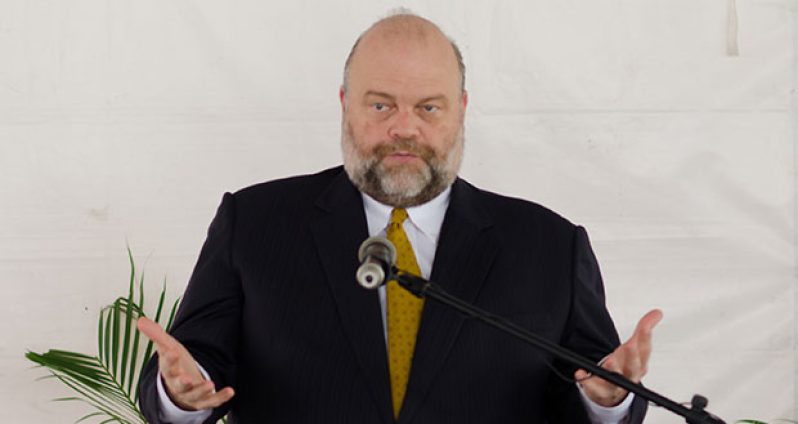THE United States Government has tripled the number of agents of its Drug Enforcement Administration (DEA) here and has also increased its level of information sharing among anti-drug agencies in recent months, the country’s top diplomat told media officials last week.
Speaking to the media last week, the United States Ambassador to Guyana, Perry Holloway revealed that the DEA has been fostering extensive engagements with local agencies towards battling the trade of narcotics. Holloway disclosed that the DEA has begun training of local officers- not limited to the Customs Anti-Narcotics Unit (CANU) specialists but other law enforcement agencies as well. He noted that “it [the DEA] has been gathering and sharing information with CANU and other criminal investigative units in Guyana to decrease the narcotics trade as much as possible.” The DEA office, the ambassador further disclosed, “has been tripled in size” and that “it is safe to say that the unit is fully staffed and we can expect an increase in information sharing in the coming months.”
When questioned about overall crime in Guyana also, he said, “the job of decreasing criminal activities is a tough job but progress is being made and we look forward to good things in the near future.” The Ambassador had said in February at the opening of the DEA Office in Guyana that the agency has “no arresting powers” and that it will not be “kicking down doors and dragging people out on the streets” but will rather be engaged in the sharing of information.
This ‘information sharing’ entails the US agency working along with the local anti-narcotic and other law enforcement agencies in Guyana towards tackling drug trade by providing information to the local agencies that will aid in countering the trade of narcotics. He had explained that the role of the DEA in Guyana was not be providing as much funds, but “bringing the expertise in the people, the networks and the information gathering tools to be able to leverage information and their network throughout the world.”
“To have the DEA in Guyana will bolster and enhance the efforts of the Guyana Police Force, CANU and the GRA drug enforcement unit,” Holloway said. Prior to the establishment of the DEA in Guyana in February of this year, narcotic issues in Guyana and the DEA’s relation to these issues were handled by the DEA in Trinidad. Guyana is the eighth Caribbean and Latin American country to have the permanent presence of a DEA office.
Meanwhile, in its 2016 International Narcotics Control Strategy Report (INCSR) the US had said that Guyana lacks a comprehensive demand reduction strategy that adequately addresses drug rehabilitation. It observed that Marijuana is the most widely used drug in Guyana, followed by cocaine. “The Guyana National Council for Drug Education, Rehabilitation, and Treatment, within the Ministry of Public Health, is the single government body responsible for addressing demand reduction. Non-governmental organizations also offer rehabilitation services. The University of Guyana initiated a demand reduction curriculum through OAS/CICAD funding. As part of CBSI, the United States supports a ‘Skills and Knowledge for Youth Employment’ project that provides vulnerable youth with alternatives to drug-related activities and provides skills for transitioning to the work force.” According to the report the United States supports a wide range of efforts designed to address crime and violence affecting Guyanese citizens, primarily through CBSI.
President David Granger late last week said that the root causes of crime have to be addressed in order for there to be long- term results. He said that crime and the safety of all Guyanese have become issues of daily preoccupation which his Government views as of critical concern. He acknowledged that the trafficking in narcotics is a major factor. To this end the National Anti-Narcotic Agency (NANA) will be set up as the Government looks to work more closely with regional and international partners to address this trans-national crime.
“Crime is very complex, when you deal with crime you have to look at causation, in my view many of the most serious crime arise out of the narcotics trade that is a trade that I think is responsible for bringing drugs into the country and guns.” The President went on to explain that with the volume of money that is generated from the narcotics trade the loyalty of the law enforcement officers and even the magisterial officers came under threat. He said that his Government is working on a broad-base strategy to address crime which would include the setting up of a national intelligence service. In addition, Minister of Public Security, Mr. Khemraj Ramjattan reported in September that he had completed the drafting of National Drug Strategy Master Plan.
The administration is also working to ensure that the GPF is better equipped and is able to operate in the diverse areas of the country. President Granger explained that given Guyana’s size and terrain the Force is working to ensure that there are more mounted police in areas like the Rupununi, which cannot be adequately covered by vehicles alone and in certain back dams on the coast like Black Bush Polder in Corentyne-Berbice, where heinous murders have recently occurred.
“We have to provide the police with improved assets…All-Terrain Vehicles [ATVs] and more river crafts to improve their mobility… I reckon that in the fullness of time we will overcome some of the crime problems we have here,” President Granger said.



.jpg)









